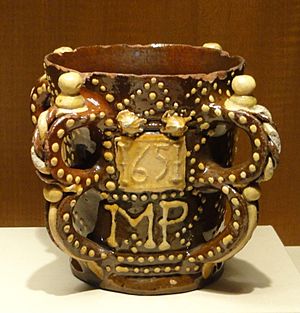Tyg facts for kids
A tyg (pronounced "tig") is a special type of mug from old England. It's not like a regular mug because it has three or more handles! People used tygs for drinking, and the many handles made it easy for several friends to share a drink. It also helped pass hot drinks around without burning hands.
These tall mugs were usually black and made from red clay. They were popular from the 15th century to the mid-17th century. Some tygs even had as many as nine handles!
Where Tygs Were Made
Tygs were made in large numbers in places like Wrotham in Kent and in many factories in Staffordshire, England. People have found tygs at old colonial sites in America from the 17th century, as well as in the United Kingdom. There are also some tygs from Japan and Germany, showing this idea spread.
Tiny Tygs
Did you know there are also tiny tygs? Many famous pottery makers in Staffordshire and Worcester made miniature tygs. These small versions are only about 1 to 1.7 inches tall. They were probably not used for drinking. Instead, they were often beautifully painted and used as decorations. Today, many people enjoy collecting these small, artistic tygs.
Frilly-Based Tygs
The term 'frilly-based tyg' describes a different kind of old drinking mug. These mugs were made during the medieval period and soon after. They usually had a round bottom and a straight or flared top.
The "frilly base" refers to the bottom ring of the mug. After the potter shaped the mug on a wheel, they would use their fingers to make the base look wavy or "frilly." This style became popular around the year 1300. It was first seen in strong, hard pottery from places like Siegburg, Germany, and Raeren, Belgium. These mugs were brought to England in large amounts. English potters then started to copy this unique frilly design.


